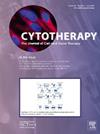Enhancing photodynamic and radionuclide therapy by small interfering RNA (siRNA)-RAD51 transfection via self-emulsifying delivery systems (SNEDDS)
IF 3.7
3区 医学
Q2 BIOTECHNOLOGY & APPLIED MICROBIOLOGY
引用次数: 0
Abstract
Background aims
Gene-silencing by small interfering RNA (siRNA) is an attractive therapy to regulate cancer death, tumor recurrence or metastasis. Because siRNAs are easily degraded, it is necessary to develop transport and delivery systems to achieve efficient tumor targeting. Self-nanoemulsifying systems (SNEDDS) have been successfully used for pDNA transport and delivery, so they may be useful for siRNA. The aim of this work is to introduce siRNA-RAD51 into a SNEDDS prepared with Phospholipon-90G, Labrafil-M1944-CS and Cremophor-RH40 and evaluate its efficacy in preventing homologous recombination of DNA double-strand breaks caused by photodynamic therapy (PDT) and ionizing radiation (IR).
Methods
The siRNA-RAD51 was loaded into SNEDDS using chitosan. Transfection capacity was estimated by comparison with Lipofectamine-2000.
Results
SNEDDS(siRNA-RAD51) induced gene silencing effect on the therapies evaluated by cell viability and clonogenic assays using T47D breast cancer cells.
Conclusions
SNEDDS(siRNA-RAD51) shown to be an effective siRNA-delivery system to decrease cellular resistance in PDT or IR.
通过自乳化递送系统(SNEDDS)转染小干扰 RNA(siRNA)-RAD51,增强光动力和放射性核素疗法。
背景目的:利用小干扰 RNA(siRNA)进行基因沉默是一种极具吸引力的疗法,可用于调节癌症死亡、肿瘤复发或转移。由于 siRNA 容易降解,因此有必要开发运输和递送系统,以实现高效的肿瘤靶向治疗。自纳米乳化系统(SNEDDS)已成功用于 pDNA 的运输和递送,因此也可用于 siRNA。这项工作的目的是将 siRNA-RAD51 导入用磷脂-90G、Labrafil-M1944-CS 和 Cremophor-RH40 制备的 SNEDDS 中,并评估其在防止光动力疗法(PDT)和电离辐射(IR)引起的 DNA 双链断裂的同源重组方面的功效:方法:使用壳聚糖将 siRNA-RAD51 装入 SNEDDS。方法:利用壳聚糖将 siRNA-RAD51 装入 SNEDDS,并通过与 Lipofectamine-2000 的比较估算转染能力:结果:SNEDDS(siRNA-RAD51)诱导的基因沉默对治疗的影响通过使用 T47D 乳腺癌细胞进行的细胞活力和克隆形成试验进行了评估:结论:SNEDDS(siRNA-RAD51)是一种有效的 siRNA 递送系统,可降低 PDT 或 IR 的细胞耐药性。
本文章由计算机程序翻译,如有差异,请以英文原文为准。
求助全文
约1分钟内获得全文
求助全文
来源期刊

Cytotherapy
医学-生物工程与应用微生物
CiteScore
6.30
自引率
4.40%
发文量
683
审稿时长
49 days
期刊介绍:
The journal brings readers the latest developments in the fast moving field of cellular therapy in man. This includes cell therapy for cancer, immune disorders, inherited diseases, tissue repair and regenerative medicine. The journal covers the science, translational development and treatment with variety of cell types including hematopoietic stem cells, immune cells (dendritic cells, NK, cells, T cells, antigen presenting cells) mesenchymal stromal cells, adipose cells, nerve, muscle, vascular and endothelial cells, and induced pluripotential stem cells. We also welcome manuscripts on subcellular derivatives such as exosomes. A specific focus is on translational research that brings cell therapy to the clinic. Cytotherapy publishes original papers, reviews, position papers editorials, commentaries and letters to the editor. We welcome "Protocols in Cytotherapy" bringing standard operating procedure for production specific cell types for clinical use within the reach of the readership.
 求助内容:
求助内容: 应助结果提醒方式:
应助结果提醒方式:


